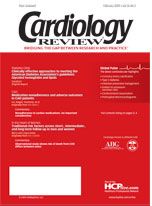Publication
Article
Cardiology Review® Online
Fish consumption and stroke risk in elderly individuals: The catch of the day
The article by Mozaffarian and colleagues (page 20) details results of a prospective dietary study in 4,778 individuals aged 65 and older, which is in its conception both insightful and gratifying. The study concludes that risk of stroke, particularly ischemic stroke, can be reduced by up to 30% by modest weekly intake of “fatty” (eg, tuna, salmon) unfried fish. This study is somewhat unique in that it restricts its cohort to individuals who are primarily at risk for stroke, namely the elderly. Fully two thirds of all strokes occur after age 65, and the risk after this age increases throughout late life.1 Moreover, the study is especially powerful because it is prospective, and it follows the cohort over a sufficiently long period to accumulate relatively large numbers of stroke end points.
Previous studies on this issue have had some conflict in their results. An excellent meta-analysis of the nine cohort studies that have been undertaken calculated pooled relative risks to be at least 32% less for those who consumed fish at least once a month.2 Two large studies3,4 did not demonstrate this benefit, but the numbers of stroke end points were very low in both, suggesting that the participants were not followed into late life. In fact, the famed Physicians’ Health Study4 followed 21,185 men with an average age of only 51 for a mere 4 years. It should not be surprising, then, that only 173 strokes were observed in this setting. The authors concluded that fish consumption was not protective for stroke (or cardiovascular disease). An equally pertinent, if cynical, conclusion might have been that for younger individuals such as those in this cohort with an approximate annual stroke risk of 0.2%, the point is moot. Moreover, the putative beneficial mechanisms of the n-3 fatty acids in fatty fish include platelet inhibition and improvement of vascular reactivity.5,6 Unlike an intervention that would (only) inhibit chronic atherogenesis, these benefits would seem to confer a more immediate protection from platelet aggregation and ischemia in an aging—and potentially already atherosclerotic—cerebral circulation.
The study by Mozaffarian and colleagues included 4,778 men and women free of cerebrovascular disease at baseline, who filled out dietary questionnaires which stratified fish intake by frequency as well as type—particularly fried versus broiled/baked fish, and tuna. A subset of participants was shown to have correlation between n-3 fatty acid plasma concentration with intake of the broiled/baked/tuna fish but not fried fish. In 12 years of follow-up, 626 incident strokes were documented, of which 537 (86%) were ischemic. This implies an approximate stroke incidence of 3.2% per year, consistent with data from the Framingham study.1 The relative risk of overall and especially ischemic stroke was reduced by at least 26% with the consumption of broiled/baked/tuna fish but not fried fish/fish sandwich consumption. No significant benefit (or risk) was conferred by any fish for hemorrhagic stroke. Given the putative mechanisms of n-3 fatty acids, I wonder if the end points were further stratified to include ischemic stroke subtypes, if fish consumption would have shown even greater protection against atherothrombotic ischemic stroke.
There are many strengths of this study, particularly in terms of its prospective nature and the cohort, as noted above. Further, the n-3 fatty acid correlation substudy is reassuring, as are the analyses adjusting for confounding factors such as education, smoking, or aspirin use. There may, of course, be other “unmeasured or imprecisely measured” confounders such as elements of a healthy lifestyle, for example, increased exercise and moderate wine intake in those who enjoy baked/broiled fish, versus sedentary lifestyle and higher consumption of other fatty foods in those who do not enjoy these foods. This seems to be at least suggested in the higher relative risks of those in the study who consumed fried fish/fish sandwiches. However, these considerations are largely outweighed by the consistency of results after other adjustments in the study, and with the results of other large studies.
The results of the study by Mozaffarian and colleagues apply to precisely that population in which primary stroke prevention is of greatest importance. Furthermore, the results are easily and immediately applicable to this population, particularly as the interven-tion only involves eating at least one meal of fatty fish per week. In summary, this study is very generalizable, highly believable from a biological standpoint, and readily usable in practice. For the majority of my stroke-prone patients, and certainly for those of any elderly caregiver, it is the catch of the day.
